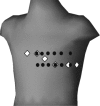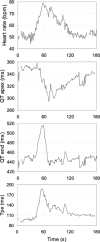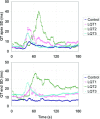Epinephrine bolus test in detecting long QT syndrome mutation carriers with indeterminable electrocardiographic phenotype
- PMID: 21496168
- PMCID: PMC6931997
- DOI: 10.1111/j.1542-474X.2011.00426.x
Epinephrine bolus test in detecting long QT syndrome mutation carriers with indeterminable electrocardiographic phenotype
Abstract
Background: In long QT syndrome (LQTS), prolonged and heterogeneous ventricular repolarization predisposes to serious arrhythmias. We examined how QT intervals are modified by epinephrine bolus in mutation carriers of three major LQTS subtypes with indefinite QT interval.
Methods: Genotyped, asymptomatic subjects with LQTS type 1 (LQT1; n = 10; four different KCNQ1 mutations), type 2 (LQT2; n = 10; three different HERG mutations), and type 3 (LQT3; n = 10; four different SCN5A mutations), and healthy volunteers (n = 15) were examined. Electrocardiogram was recorded with body surface potential mapping system. After an epinephrine 0.04 μg/kg bolus QT end, QT apex, and T-wave peak-to-end (Tpe) intervals were determined automatically as average of 12 precordial leads. Standard deviation (SD) of the 12 channels was calculated.
Results: Heart rate increased 26 ± 10 bpm with epinephrine bolus, and similarly in all groups. QT end interval lengthened, and QT apex interval shortened in LQTS and normals, leading to lengthening of Tpe interval. However, the lengthening in Tpe was larger in LQTS than in normals (mean 32 vs 18 ms; P < 0.05) and SD of QT apex increased more in LQTS than in normals (mean 23 vs 7 ms; P < 0.01). The increase in Tpe was most pronounced in LQT2, and in SD of QT apex in LQT1 and LQT2.
Conclusions: Abrupt adrenergic stimulation with a moderate dose of exogenous epinephrine affects ventricular repolarization in genotype-specific fashion facilitating distinction from normals. This delicate modification may help in diagnosing electrocardiographically silent mutation carriers when screening LQTS family members.
©2011, Wiley Periodicals, Inc.
Figures



References
-
- Lehnart S, Ackerman M, Benson W, et al Inherited arrhythmias. Circulation 2007;116:2325–2345. - PubMed
-
- Zareba W, Cygankiewicz I. Long QT syndrome and short QT syndrome. Prog Cardiovasc Dis 2008;51:264–278. - PubMed
-
- Rautaharju P, Surawicz B, Gettes L. AHA/ACCF/HRS recommendations for the standardization and interpretation of the electrocardiogram. Circulation 2009;119:e241–e250. - PubMed
-
- Shimizu W, Antzelevitch C. Sodium channel block with mexiletine is effective in reducing dispersion of repolarization and preventing torsade de pointes in LQT2 and LQT3 models of the long QT syndrome. Circulation 1997;96:2038–2047. - PubMed
Publication types
MeSH terms
Substances
LinkOut - more resources
Full Text Sources
Miscellaneous

